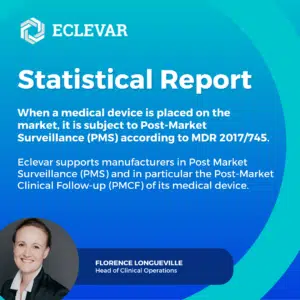When a medical device is placed on the market, it is subject to Post-Market Surveillance (PMS) according to MDR 2017/745.
Eclevar supports manufacturers in Post Market Surveillance (PMS) and in particular the Post-Market Clinical Follow-up (PMCF) of its medical device. The clinical evaluation is the cornerstone of demonstrating compliance with the General Safety and Performance Requirements(GSPR) of the medical device. It must provide sufficient and relevant clinical data evidence about safety and performance for this demonstration.
A clinical investigation is one of the tools available to the manufacturer to provide this clinical evidence. Regardless of its type, a clinical investigation is performed on a sample of patients.
The clinical investigation is defined, justified, and documented in the Clinical Investigation Plan
According to ISO14155 2020, the CIPhas several parts useful for the analysis of clinical data:
- Description, characteristics, and analysis of patient population.
- Descriptive statistics of baseline data, treatments, safety-related data, and, if applicable, primary and secondary endpoints.
- Analytical procedures including measures of precision, such as confidence intervals, if applicable.
- Significance level and power of primary endpoint(s) and, if applicable, overall statistical verification strategy.
- o Sample size calculation and justification. In all studies, the pre-existing terms for this step are power, alpha risk, and the ratio between groups. According to ISO14155 2020, the CIPhas several parts useful for the analysis of clinical data:
- o Other elements necessary to calculate the number of subjects will depend on the objective or type or design of clinical investigation:
- for 2 groups: comparison of proportions, averages, durations (survival)
- for observational studies: cohort, case-control.
- Justification of the number of procedures to be performed.
- Success/failure criteria applied to the results of the clinical investigation.
- Setting up an intermediate analysis.
- Management of bias.
- Management of potential confounding factors.
- Description of procedures for controlling multiplicity and adjusting for error probabilities.
- Specification of subgroups for analysis.
- Management, justification, and recording of missing, unused, or erroneous data.
- Exploratory and sensitivity analysis.
- Procedures for reporting deviations from the original statistical analysis plan.
- For multi-centers clinical investigations, a strategy for managing potential imbalances in enrolment between different investigative sites.
- Data pooling strategy.
Once the CIP has been written and approved, the electronic Case Report Form (eCRF) is then designed by the Data Manager in collaboration with the biostatistician. For the eCRF to be as efficient as possible, several steps are necessary:
- Reconciliation, review, and validation of eCRF to ensure that it reflects and enables data collection per protocol.
- Design: this corresponds to a database built in the eCRF software. It is during this step that name and type of the variable are assigned.
- Setting up an intermediate analysis.
- Options can then be added: optional pages or variables depending on previous entries these allow you to limit the number of errors.
- o presence or absence of data (for example, if an examination is done, the date must be filled in)
- o data formats (for example, a date must be in DD/MM/YYYY format) data consistency (for example, the treatment date cannot be before the diagnosis date).
- User Acceptance Test: this session is a thorough and rigorous review and testing of eCRF by all parties prior Go Live.
- eCRF Go Live: release of validated eCRF, ready for data entries.
The Statistical Analysis Plan (SAP) is written when the CIP is approved and the eCRF is built before the first patient is included in the study.
The Statistical Analysis Plan thus follows an accurate, defined, described, and documented process. A strong SAP increases the success of the clinical investigation
There are several important points to consider when writing an SAP:
- Detailing the planned statistical analysis.
- Developing the key features of the technical analysis.
- Objectives of the trial.
- Data sources.
- Study population.
- Study parameters.
- Statistical methodology as examples:
- Statistical tests for group comparison if any (T-test, Chi test, ANOVA…).
- Kaplan Meier analysis for survival data (or log-rank test ..).
- Cox cause-specific model for cumulative incidence, emerging risk analysis.
- Evaluation of correlation coefficient between variables.
- ROC curve and AUC to analyze the effects of varying decision thresholds, accounting for all possible combinations of various correct and incorrect decisions (sensitivity/specificity).
- missing data management.
- data sources.
The SAP for the clinical investigation should be developed following a thorough discussion between the sponsors and the methodologist allocated to the study and the statistician.
Once the SAP has been written, clinical data entry by the investigating physician can start. The edit checks defined during the design of the eCRF are executed and alert the doctors at the time of entry.
If the inconsistencies are not corrected at the end of the data entry process, queries or Data Clarification Forms (DCFs) will be sent to investigators. This allows for avoiding data inconsistencies but also any missing data that could lead to a bias and a loss of power in the statistical analysis.
Once the DCFs have been corrected and the monitoring has been done, the data manager can freeze the database.
When the database is frozen, the biostatistician has the correct and clean data to execute the statistical analysis plan. The biostatistician can then begin to prepare the statistical report.
The statistical analysis report (SAR) is then done in several steps:
- Reflection on the SAR structure: how to organize it and ensure that all information in the protocol is present. According to ISO14155:2020, it must include:
- o the start date and end date (or suspended date) of the clinical investigation.
- o subject distribution: number of screened, excluded, randomized, withdrawn, early terminated, and treated patients.
- o subject demographics and other relevant baseline characteristics.
- o compliance with the CIP.
- o an analysis with reasons and justifications that includes:
- All clinical performance, efficacy, or safety analyses per objectives, endpoints, and outcomes defined in CIP.
- A summary of all Adverse Events (AEs).
- A table of all device defects that could have resulted in an AE/AE.
- All necessary subgroup analyses.
- A count of all subjects with a description of how missing data or discrepancies were handled in the analysis.
- Clear distinctions between main analyses, other pre-specified analyses, and additional analyses.
- A list of deaths and their causes.
- Variables built from the raw variables: Data sort to build variables required for the analysis. For example, building variables with information already present in the eCRF (BMI with weight and height, a delay with two dates…), building delays for survival analyses…
- Set-up statistical models based on SAP.
- Ext extraction of statistical models into illustrated results (tables, figures, curves …).
- Writing and importing illustrated results into the statistical report.
At Eclevar, such analyses are performed with RStudio® software and the SAR is written in RMardown (an extension that allows dynamic document generation by mixing formatted text and results produced by RStudio® code).


The advantage of using these two programs is that the statistical report can be adapted. Indeed, if the data are updated, the RStudio® program reads and analyzes new data. The new data will then be directly modified in the SAR.
At Eclevar, the statistical report is systematically reviewed by a senior biostatistician who hold strong expertise and knowledge in clinical investigations. This step ensures the quality of the statistical analyses and consequently the quality of the SAR.
The finalized SAR is included in the Clinical Study Report (CSR).
The Medical Writer (MW) writes the clinical analysis of the CSR and the conclusion of the clinical investigation based on the results of the statistical analysis.
The CSR is then sent to the client for review, validation, and signature.
Thank you for your time, and interest. ECLEVAR MedTech posts regularly on topics related to Medical Devices and IVDs – Regulatory, Clinical, Medical Writing, in Australia, the EU, UK, and the USA.
Check-out for our next interesting blog.
ECLEVAR MEDTECH is a global CRO, headquartered in Paris. We support medical device and IVD manufacturer in the MDR and IVDR transition. Our team works as an extension team of medical affairs and regulatory affairs sponsor. We offer customized service, personalized to the need of our clients. Whether you are looking for full service CRO or staffing clinical or regulatory experts, our management team with more than 20 years experience will drive you to the effective solution Please contact us at clientcare@eclevar.com to learn more.

